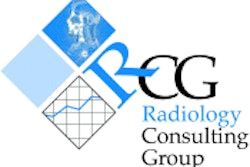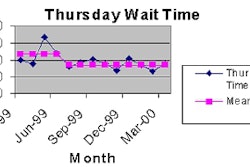
This is the fifth in a monthly series of coding-specific articles for U.S.-based radiology practitioners. They appear each month on AuntMinnie.com courtesy of Coding Strategies Incorporated. If you'd like to offer your comments about the material, please e-mail [email protected].
By Melody W. Mulaik
Coding Strategies Incorporated

For radiology there are three main schools of thought regarding how the assignment of CPT-4 (Current Procedural Terminology, 4th Edition) procedure and ICD-9 (International Classification of Diseases, 9th Revision) diagnosis codes should occur. Some practices rely completely on the physicians to capture information on a charge ticket or similar charge-capture mechanism. A few practices rely on data from other healthcare entities to capture information, such as hospital interfaces. However, most firms utilize individuals designated as coders to perform this function.
Performing the medical coding function for radiology consists of assigning the accurate procedure code for the service(s) rendered. In addition to selecting the correct procedure code(s), the correct diagnosis code must also be determined after the completion of the exam (For additional information on correct diagnosis coding practices, see New diagnosis guidelines could affect your operations and reimbursement, December 18, 2001).
Let’s examine the three coding scenarios, and their advantages and disadvantages.
Physician coding
I’ve heard coders say that "physicians should do the coding because they are the only ones who know what they did." That may be a dangerous assumption because the dictation must clearly support the assigned diagnosis and procedure codes. It is important to keep in mind that many of the individuals reading radiology reports are not physicians but rather coders, insurance claims adjusters, and auditors.
Understandably, some physician practices have taken the stance that since they are ultimately responsible for the code selection, they should personally perform this function. When the radiologists are actively involved in ensuring comprehensive documentation and accurate coding, positive results follow. Interventional procedures lend themselves easily to physician coding with the use of comprehensive charge tickets. The key is ensuring that the dictated radiology report appropriately supports the submitted charges.
Another reason physicians perform the coding function is that it is sometimes difficult to find appropriately trained coding personnel. In freestanding facilities, a charge ticket can easily be utilized for this purpose, usually with the technologist checking off, or at least verifying, the exam selection. On the downside, unless appropriate quality checks are in place, procedure codes may be selected that are not supported by the radiology report.
The assignment of diagnosis codes is a much more time-consuming process than procedure coding, and requires navigating through the ICD-9-CM coding manual. Assigning the most accurate codes (including the appropriate fourth and fifth digits) is challenging even for someone devoted full-time to the process, much less a physician with clinical and productivity concerns.
A diagnostic "cheat sheet" is often utilized to minimize the coding time requirement; however, this is a double-edged sword. Ease and efficiency can easily replace accuracy. It is very tempting to select a diagnosis code that "approximates" or "is close enough" to justify the radiology exam performed. But keep in mind that this practice spells trouble in an audit. Some of the highest coding error rates I have seen in audits were in practices where the physicians performed the coding function.
Bottom line: Although interventional procedure coding can be adequately covered with charge tickets, assigning accurate and complete diagnostic radiology procedure codes and diagnosis codes requires a great deal of time and effort by physicians to ensure accuracy.
Interface data
Some hospital-based practices rely on coding information obtained from the hospital’s billing system or RIS. Hospitals generally utilize a charge description master (CDM) to define and capture their codes and charges for radiology services. If the CDM is not updated frequently and accurately, the information may be out of date or incorrect.
Unless good operational processes are in place, the hospital will bill what was entered into the system as scheduled -- not as performed. For example, a study that was performed "with contrast" might be coded without the contrast charge, or vice versa. An exam may be missed because the correct study was not scheduled (for example, an upper gastrointestinal exam was scheduled but only an esophagram was performed).
Hospitals often charge multiple CDM line items, and utilize bundling software to adjust them as needed before sending a claim. If the physician practice does not utilize similar billing mechanisms, unbundling can occur.
For interventional procedures, there is a great chance of charges being missed by the physician if only hospital information is utilized. Hospitals across the U.S. are evaluating their interventional coding processes to ensure appropriate and optimum coding and reimbursement.
Bottom line: Utilizing hospital information for physician coding has historically yielded a high error rate in coding audits. The matching of physician and facility charges is coming under greater scrutiny by third-party payors, and should be evaluated proactively.
The Department of Health and Human Services Office of Inspector General (OIG) Work Plan Fiscal Year 2002 contains the following statement: "We plan to review the procedure coding of outpatient services billed by a hospital and a physician for the same service. In a previous review, we identified a 23% nationwide rate of inconsistency between hospital outpatient department procedure coding and physician procedure coding for the same outpatient service." Physicians and hospital staff should work closely together to ensure that billing for both organizations is supported by the radiology dictation.
Designated coders
The majority of radiology practices have chosen to designate medical coders to perform this important function. Assigning medical codes has evolved from a clerical function to that of a coding professional.
Staying on top of the coding industry requires employees who are dedicated to continual professional improvement and expanded knowledge. Coding and compliance rules are constantly changing, so discerning the impact of these changes is not always easy.
If you utilize coders, it is important that they possess the skills needed to perform accurately and efficiently. Just because someone has been coding for years doesn't mean that he or she has been doing so accurately. And merely passing a certification test does not guarantee adequate skills.
There are excellent radiology coders around the country. It is important that you accurately ascertain your coding staff’s skill set to ensure that no unexpected coding surprises await you in an audit situation.
And while certification doesn't guarantee perfect coding, such individuals are generally seeking professional advancement, and want to do the best they can. When a coder is nationally certified, it means that he or she has successfully passed a certification test administered by a nationally accredited organization.
At the present time there are only three national certifying organizations in the U.S. The certifications that you will generally find for professional/physician-based radiology coders are the certified professional coder (CPC), certified coding specialist -- physician-based (CCS-P), and radiology-certified coder (RCC). For the facility component, the certifications most often encountered are the registered health information administrator (RHIA), registered health information technician (RHIT), certified coding specialist (CCS), and certified professional coder-hospital (CPC-H).
The American Academy of Professional Coders (AAPC) administers and maintains the CPC designation that covers all physician services. The American Health Information Management Association (AHIMA) administers and maintains several certifications, including the CCS-P. The newly established RCC designation, sponsored by the Radiology Business Management Association (RBMA), is the only specialty-specific national certification currently in existence.
Other organizations, such as private companies and junior colleges, offer their students certification after completing a designated program. However, these designations are not nationally recognized certifications and should not be interpreted as such. Whatever national certification your coders possess, they will need to obtain continuing educational units (CEUs) on an annual or bi-annual basis. The CEUs for each certification vary and should be evaluated to ascertain ongoing costs and time requirements.
Bottom line: Utilizing coding professionals is an effective and accurate way to address the challenges of medical coding. Assessing your coding staff’s skill set accurately can help you avoid coding surprises in an audit situation.
Resources
Regardless of who performs the coding function, it is important that your practice have the appropriate coding tools. The following is a list of resources to ensure that your coding and billing practices are correct and up to date. There are many other publications and information sources available, and their omission from this list should not be interpreted negatively.
|
Coding Tool Resources |
|
|
Tool |
Description |
|
Dorland’s Illustrated Medical Dictionary -or- Stedman’s Medical Dictionary (1 per office or team)
These are available from a number of suppliers, and prices vary accordingly. |
Basic word elements, biographical information, eponyms, main and subentries, cross references, synonyms, etymology, official terminology, abbreviations, and an anatomical appendix with charts. |
|
|
|
|
Netter’s Atlas of Human Anatomy (1 per office)
This is available from a number of suppliers, and prices vary accordingly. |
One of the most comprehensive medical illustration books available. All anatomical structures are clearly labeled and depicted to ease clinical translation and accurate code assignment. |
|
|
|
|
Current Procedural Terminology (1 per procedural coder)
Available from Medicode http://mbbnet.umn.edu/ (800) 999-4600 |
Descriptive terms and identifying codes used to report medical services and procedures performed by physicians. |
|
|
|
|
CPT Assistant (1 per office)
Available from the AMA (800) 621-6246 |
Periodical, published monthly by the American Medical Association (AMA). Contains articles pertaining to specific CPT coding scenarios and offers instruction regarding the proper use of the CPT manual. Information includes yearly updates to the CPT manual and examples on how to correctly assign CPT codes in unique billing situations. |
|
|
|
|
International Classification of Diseases, 9th Revision, Clinical Modification (ICD-9-CM) (1 per diagnostic coder)
Available from Medicode http://mbbnet.umn.edu/ (800) 999-4600 |
Contains the diagnosis codes used to document patient signs and symptoms, causes or complaints, or the overall reason for the medical service or procedure performed in a physician’s office or in a facility. Diagnosis codes are used to establish medical necessity for procedures, and to indicate the severity and emergent nature of the condition or complaint. |
|
|
|
|
ICD-9-CM Coding Clinic (1 per office)
Available from the AHA (800) 261-6246 |
Periodical, published quarterly by the American Hospital Association (AHA). Contains articles on how to properly use ICD-9-CM codes in various coding scenarios, including outpatient physician billing. |
|
|
|
|
HCFA Common Procedure Coding System (HCPCS) (1 per procedural coder)
Available from Medicode http://mbbnet.umn.edu/ (800) 999-4600 |
Contains codes (established by the Centers for Medicare and Medicaid Services) used to report medical services and supplies not listed in the CPT manual. |
|
|
|
|
Interventional Radiology Coding Users’ Guide (1 per office)
Available from SCVIR (800) 488-7284 |
Annual interventional coding guide published collectively by the Society of Cardiovascular and Interventional Radiology (SCVIR), American College of Radiology (ACR), RBMA, and American Healthcare Radiology Administrators (AHRA). |
|
|
|
|
Radiology Coding Alert (1 per office)
Available from The Coding Institute http://codinginstitute.com/ (800) 508-2582 |
Monthly radiology specific newsletter published by The Coding Institute that addresses diagnostic and interventional coding and compliance issues. |
|
|
|
|
Radiology Administrator’s Compliance & Reimbursement Insider (1 per office)
Available from Brownstone Publishers http://www.brownstone.com/ (800) 643-8095 |
Monthly radiology specific newsletter published by Brownstone Publishing that focuses on operational, coding, and financial concerns for radiology practices. |
|
|
|
|
ACR Bulletin (1 per office)
Available from the ACR (800) 227-5463 |
Periodical, published monthly by the ACR. Includes rules, regulations, CPT coding tips, and codes of conduct for radiologists. Members receive a discount. |
|
|
|
|
The RBMA Bulletin (1 per office)
Available from the RBMA http://www.rbma.org/ (888) 224-7262 |
Periodical, published monthly by the RBMA. Contains practice management guidelines for radiologists, information regarding billing trends in the radiological field, and regulatory updates to radiology procedures. |
|
|
|
|
Coding Guide for Radiology (1 per coder)
Available from CSI http://www.codingstrategies.com/ (877) 626-3464 |
Comprehensive reference book for all diagnostic radiology procedures. Includes detailed information about each code, layman’s descriptions of surgical procedures, comprehensive glossary, and authoritative guidance. |
|
|
|
|
Coding Guide for Interventional Radiology (1 per coder)
Available from CSI http://www.codingstrategies.com/ (877) 626-3464 |
Comprehensive reference book for all interventional radiology procedures. Includes easy-to-use anatomical illustrations to assist with code selection. More than 50 case studies are presented with clear coding rationales. |
By Melody Mulaik
AuntMinnie.com contributing writer
March 27, 2002
Melody Mulaik is president of Coding Strategies Incorporated.
Related Reading
Necessity criteria compliance critical for PET reimbursement, February 28, 2002
New Year brings new coding and bundling changes, January 18, 2002
New diagnosis guidelines could affect your operations and reimbursement, December 18, 2001
Order compliance equals payment for outpatient radiologists, November 19, 2001
Copyright © 2002 Coding Strategies Incorporated



















